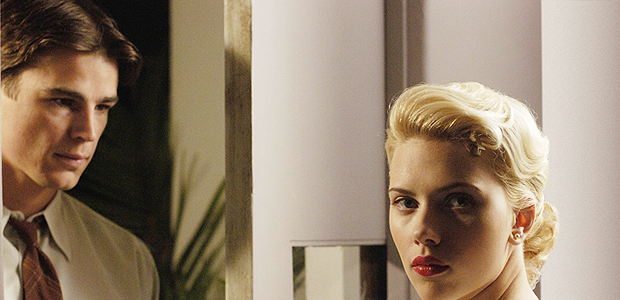The Black Dahlia

Directed by Brian De Palma, 121 mins, Rated R

Review by Paul Stathakis | 2006
Not "The Blue Dahlia"
Brian De Palma is a veteran director whose résumé features a list of notable films such as “Blow Out” (1981), “The Untouchables” (1987), and “Carlito’s Way” (1993). De Palma undoubtedly has a flair for directing and his images are continuously spellbinding. With “The Black Dahlia” he revisits 1947, a time where detectives were slick, chain-smoking there way through every investigation, wearing fedoras, and driving nice cars. “The Black Dahlia”, loosely based on a novel by James Ellroy, is centred on the murder of Elizabeth Short (Mia Kirshner), a B movie actress.
Bucky Bleichert (Josh Harnett) is assigned to Short’s case along with his ill-tempered partner Lee Blanchard (Aaron Eckhart) who becomes obsessed with solving the case. We learn that Short was an aspiring actress who came to Hollywood (then known as Hollywoodland) for a taste of fame and glory. But then we get a glimpse of Elizabeth Short’s audition. The footage shows her crawling, being seductive for the camera or the mystery man sitting behind it. We see her crying with makeup running down her face and her tears never seem part of a performance. Auditions never go that far and so, we get the idea.
The detectives examine pictures of her brutal murder as viewers also try to figure out who committed the crime. Bucky soon realizes that his girlfriend, Madeleine (Hilary Swank) had ties to the deceased, and soon after that, he begins uncovering corruption within the police department. Joining the cast is Scarlett Johansson who stars as Lee’s alluring girlfriend, Kay. Johansson’s eyes literally shine in each scene but the same cannot be said about her performance. Unlike Johansson, Hilary Swank delivers solid acting and reminds us why she is one of this generation’s best actresses. Here she is unsurprisingly seductive.
The sets, cars, and the costumes also bring a touch of noir to this thriller. Although “The Black Dahlia” sometimes has a funny way of being sophisticated, with the actors delivering explicit dialogue, there are certain scenes which stand out. Consider a moment in which Lee protects Bucky during an intense shootout. The camera moves through the action while placing us in the middle of it. It’s an exciting moment as is another scene which sort of calls to mind the famous staircase scene in “The Untouchables.”
“The Black Dahlia” is not to be mistaken with George Marshall’s classic masterpiece “The Blue Dahlia” (1946). 40 minutes into this picture it becomes clear that De Palma has ventured into a genre which requires a great plot to go along with the sharp cinematography. Not only is the story complex but it enjoys throwing names and new characters in the viewers way throughout. When the film ends we’re not quite sure what it was really about. We barely know anything about the surprise murderer. Like Richard Roeper of the Chicago Sun-Times notes, “That’s just not playing fair.”
“The Black Dahlia” relies on its good looks and the charm of the actors to be a convincing period piece. But the real mystery here is trying to understand what persuaded De Palma to direct such a minimalist screen adaptation of Ellroy’s book. “The Black Dahlia” is a incoherent thriller, hard to follow, tough to admire, a film noir that pretends to be a film noir. If there’s one film that has really disappointed me this year, this is it.
© 2006 by Paulzeye.com. All rights reserved
